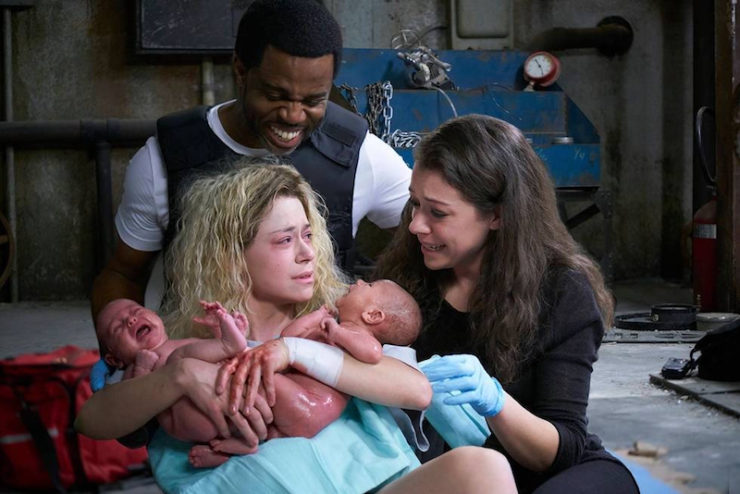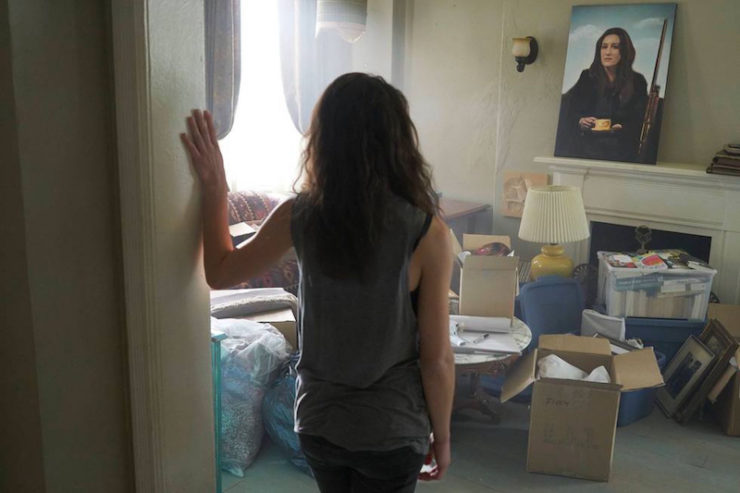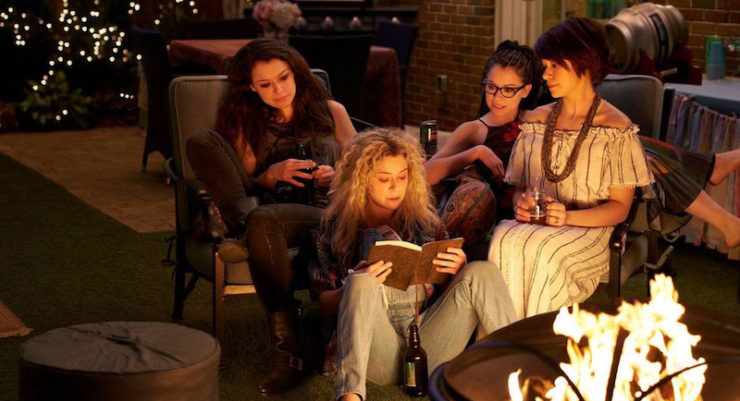For its series finale, Orphan Black took one more trip into the past, to one of the series’ most vital moments we’ve never actually seen—not Sarah meeting herself in Beth, but before that, when she did the impossible as a Leda clone and conceived a child… and then considered aborting it. In the series’ final flashback, a young, pregnant Sarah and Mrs. S sit outside a Planned Parenthood, debating the best choice for her.
“Bringing a life into this world is a really big responsibility,” Siobhan reminds her stubborn foster daughter, summing up the entire series: creating the Leda clones was never as easy as just inserting DNA into eggs; every string of numbers was a unique person despite sharing identical genetic code and the same face. Clones and conspirators on both sides have died trying to free or enslave the members of Project Leda, especially in this uneven final season, which had more than its share of series-ending sucker-punch deaths. But more crucial to the final chapter of Orphan Black than the deaths were the lives—from births to second chances to simply waking up one more day than yesterday.
Spoilers for Orphan Black 5×10 “To Right the Wrongs of Many.”
The series finale would have worked better as two separate episodes—either wrapping up the Neolution drama in the previous episode, or a two-hour finale—instead of sharing the space of one overstuffed episode. Not that I wasn’t delighted to see Coady and P.T. Westmoreland a.k.a. John handily disposed of: she falling for one last trick by Helena, he summarily silenced by an exasperated Sarah punctuating her brutal oxygen tank execution with “Ah, shut up.” But jumping from those 15 minutes of violence to a candy-coated future six months later was just too much emotional whiplash.
Helena giving birth to her babies provided something of a link between the two stories, however tenuous. In a poignant sequence, Helena’s delivery is intercut with Kira’s birth, so that Sarah takes on the role that S provided when she was just as terrified and in pain. It’s the perfect symbolic ending for Sarah and Helena, as their first encounter was Helena trying to kill yet another Leda clone; now, they’re working together to bring new life into the world, even as Sarah’s grief at losing S is still so raw she hasn’t even been able to process it. Oh, and Art is there for the birth as well, propping Helena up and crying as much as the others, and that was just so damn adorable. I’m so glad that of the many people tangential to the Clone Club who have had to die, Art was not one of them.

What’s fascinating about Orphan Black is that it telegraphed its ending from the beginning of this season: If you reread “Protest,” the poem-turned-suffragette anthem from which the episode titles were drawn, you find all of the clues to the fate of Project Leda and especially the Clone Club:
The few who dare must speak and speak again, / To right the wrongs of many: Neolution is over. The organization is ruined, all of its dirty laundry revealed to the world and its supposed immortal founder has been exposed as a fraud.
Until the manacled, slim wrists of babes / Are loosed to toss in childish sport and glee: Neither Kira nor Helena’s boys will become experiments like their mothers.
Until the Mother bears no burden save / The precious one beneath her heart: But just because Sarah and her sisters have stopped running from Neolution doesn’t mean that Sarah can stop running.
In another lovely bit of parallelism, our final hangout with the Clone Club is at Helena’s baby shower—her real one, not a hallucination to escape torture. For the most part, everyone seems to be moving on: Helena seems comfortable taking care of Orange and Purple (placeholder names, thankfully), Donnie has a new job, Art has perhaps adopted Charlotte, and everyone is one big happy family. Except for Sarah, who freezes up at her GED exam and instead does the only thing she thinks she’s capable of: She walks away from that problem and makes plans to keep on walking, selling S’s home and spiriting Kira away on some new, unknown adventure. “Freedom looks different to everyone,” she snaps at Alison when she challenges Sarah’s decision to break up the group after they’ve finally taken control of their own existence.
Getting Neolution off her back wasn’t enough, because Sarah is still haunted by even deeper-seated demons in the fear of being a bad mother—unconventional, irresponsible, unsafe, unstable. What she doesn’t realize, and what she has to hear from her sisters, is that this problem is not unique to her. The first scene of the pilot was Sarah’s realization that she is literally not alone, but five seasons later, she hasn’t learned the same figurative lesson: Alison screamed at her daughter, Helena lets her boys eat sand, and Cosima’s lack of maternal interest has her questioning if something is flawed in her nature or nurture compared to the other Ledas. Sarah is not alone in her fears.

It’s not a cathartic dance party or a rousing toast, but it’s one last incredible feat of acting by Tatiana Maslany: the narrative sleight of hand in which the viewer momentarily forgets how many times she must have shot this scene. That mastery comes down to details like how Cosima drapes herself over the chair while Alison perches herself over Cos’ legs, or Sarah affectionately winding Helena’s hair around her finger. It’s a running joke among Orphan Black fans that they’ll watch a scene and momentarily forget that it’s not a bunch of different actresses, it’s just Maslany. It’s not difficult to adopt that mindset when watching the micro expressions passing over each woman’s face or the words coming out of her mouth at the same piece of good news or another clone’s quirk: Alison pursing her lips while Sarah juts out her jaw, Cosima’s breathy giggle versus Helena’s rough mutters.
Maslany’s greatest achievement in these performances is not only her ability to carry a dozen unique characters within her, but to distinguish between them in key moments like this. You could put four women in a room and easily place them in boxes: the housewife, the scientist, the killer, the grifter. But it’s Alison who got seduced by the money and power of dealing drugs to her neighbors; Cosima who confronted her identity as a patented experiment; Helena who used the mantra of “sestras” to counter her conditioning; Sarah who finally saw her family not as marks to play but as allies with whom to let her guard down. Instead of being paper dolls with interchangeable outfits, these clones each contain multitudes. “Leda clone” is not a monolith—nor is “woman.”
So much of Orphan Black has been about breaking out of these kinds of boxes—not just the archetypal ones imposed by family or society, but what Neolution perceives as the paramount box: Project Leda, one of hundreds of other experiments with the same face. Created and observed in a controlled environment, the clones were never intended to attain more agency than Dyad chose to grant them. But one of the series’ greatest takeaways is that a woman’s personality can be made of multiple dimensions, that her decisions can’t be easily predicted nor her movements restrained. Now, with Neolution overturned, this is the crossroads moment when each clone is considering what this newfound freedom actually means for her, separate from the others.
This other remarkable aspect of this moment is that it may be the closest physical proximity between all four sestras (without anyone being intoxicated or otherwise in a state of distress) that we’ve seen in the entire series. It’s sisterly bonding at its most intimate. And then Felix comes in and blows the Clone Club wide open with a final gift from Rachel: a list of all 274 (!) Leda clones.
In an interview with Marie Claire, Maslany shared that the writers had initially envisioned a montage introducing dozens of new characters going about their daily lives, unaware of their incredible shared heritage. Unfortunately, they simply ran out of time to shoot a sequence that would involve 70 costume changes and span only a few minutes, if that. It’s really too bad, because I’m envisioning Orphan Black’s take on the Buffy the Vampire Slayer series finale with all the Potentials being activated, which would have really set off the waterworks. (Instead, that was for Helena naming her boys Arthur and Donnie.)
Yet the reveal is still significant, as it is the moment that will really challenge the notion of sisterhood. Sarah, Helena, Cosima, and Alison have been forced to confront other Ledas with their faces due to circumstances, to other clones’ lives getting tangled up in theirs; now they must choose to seek them out. For all that the Clone Club has grown close, it’s been a thorny process; the aforementioned breaking out of boxes is compounded by seeing other versions of oneself living out parallel and wildly contradictory lives. Consider Rachel: The “corporate clone” never wants to face herself again. But the Clone Club’s greatest responsibility now is to preserve the lives of their fellow clones, to ensure that these other women don’t go through what they did, to save sisters they’ve never met.
For all of its eerily accurate science and its hit-or-miss action thriller plot arcs, the best parts of Orphan Black were about these women learning how to fit each other into a makeshift family. That includes Sarah’s baggage, Alison’s addictions, Helena’s trauma, Cosima’s disease and her love story, Mrs. S’s dangerous past, Kira’s inexplicable powers, Felix’s surprise sister, Donnie’s ineptitude-turned-greatness, and every other life touched by theirs. While the journey wasn’t perfect and made some unnecessary detours over the seasons, the series picks the perfect hopeful moment to look toward: a future in which every Leda clone is safe, in which Sarah can finally stop running, and these things don’t have to be mutually exclusive.
All that said, I’ll miss the Clone Swaps, I really will. Yet I’m also glad that these women are no longer forced to disguise themselves as one another, that they don’t have to squeeze themselves into sharing the same space or replacing each other. Instead, each can finally be herself.
Natalie Zutter is fighting the urge to just turn around and rewatch season 1 now. Talk Orphan Black with her on Twitter!










